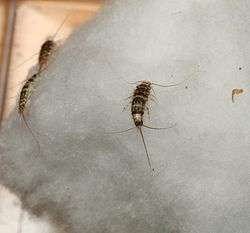Firebrat
| Firebrat | |
|---|---|
 | |
| Scientific classification | |
| Kingdom: | Animalia |
| Phylum: | Arthropoda |
| Class: | Insecta |
| Order: | Thysanura |
| Family: | Lepismatidae |
| Genus: | Thermobia |
| Species: | T. domestica |
| Binomial name | |
| Thermobia domestica Packard, 1873 | |
The firebrat (Thermobia domestica, sometimes listed as Thermophila furnorum) is a small hexapod (typically 1–1.5 cm) similar to the silverfish, both in the order Thysanura.
Firebrats prefer higher temperatures and require some humidity, and can be found in bakeries and near boilers or furnaces. They feed on a wide variety of carbohydrates and starches that are also protein sources such as dog food, flour and book bindings. They are distributed throughout most parts of the world and are normally found outdoors under rocks, leaf litter, and in similar environments, but are also often found indoors where they are considered pests. They do not cause major damage, but they can contaminate food, damage paper goods, and stain clothing. Otherwise they are mostly harmless.
At 1 1⁄2 to 4 1⁄2 months of age the female firebrat begins laying eggs if the temperature is right (32–41 °C or 90–106 °F). It may lay up to 6000 eggs in a lifetime of about 3–5 years. After incubation (12–13 days), the nymphs hatch. They may reach maturity in as little as 2–4 months, resulting in several generations each year.
References
- "Thermobia domestica - The Firebrat". BioWeb. University of Wisconsin System.
- Adam, J. A. (1933). "Biological Notes Upon the Firebrat, Thermobia domestica Packard". Journal of the New York Entomological Society. 41: 557–562.
- Ebeling, Walter (1975). Urban Entomology. University of California.
- Rust, M. K.; Millard, M. R. (2009). "Silverfish and Firebrats" (PDF). Pest Notes. Integrated Pest Management Program, University of California, Davis.
- Wygodzinsky, Pedro (1972). "A Review of the Silverfish (Lepismatidae, Thysanura) of the United States and the Caribbean Area" (PDF). American Museum Novitates. American Museum of Natural History (No. 2481).